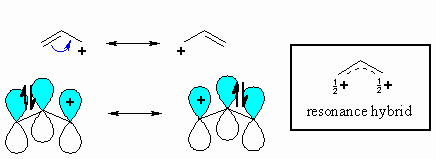A vinylic carbocation which has an empirical formula of c h is a carbocation that has a positive charge only on the alkene carbon atom.
Vinyl carbocation definition.
We know that the rate limiting step of an s n 1 reaction is the first step formation of the this carbocation intermediate.
The carbocation carbon has sp hybridization.
A carbocation may have one or more positive charges.
The rate of this step and therefore the rate of the overall substitution reaction depends on the activation energy for the process in which the bond between the carbon and the leaving group breaks and a carbocation forms.
Any trivalent disubstituted carbon is generally a vinylic carbocation in which the carbon atom which is bearing the positive charge is found to be double bonded and will always exist as sp hybridized.
Stability of carbocation intermediates.
Because of the high s character of the orbital the positive charge resides closer to the positively charged nucleus which makes it a particularly high energy cation.
The term carbocation can be defined as an ion containing a positively charged carbon atom.
Carbocation refers to the whole molecule not only the positively charged carbon atom.
Therefore carbocations are very often reactive.
Since both carbon atoms form a double covalent bond so both are sp 2 hybridized.
In the absence of geometric constraints most substituted vinyl cations carry the formal positive charge on an sp hydridized carbon atom of linear geometry.
A carbocation in which the carbon atom having the open octet and positive formal charge is part of a carbon carbon double bond.
General vinylic carbocation structure.
More generally a vinylic cation is any disubstituted trivalent carbon where the carbon bearing the positive charge is part of a double bond and is sp hybridized.
Allylic carbon atom can form stable carbocations due to electron delocalization.
Vinylic carbocations are very unstable due to lack of p character.
Allylic carbon meaning the double bonded carbon atoms can be classified as vinylic and allylic carbon atoms.
Vinylic compounds can produce vinylic polymers such as pvc pvf pvac etc.
A carbocation with a two coordinate positive carbon derived from formal removal of a hydride ion h from an alkene is known as a vinyl cation.
The vinyl cation puts positive charge at an sp hybridized carbon atom.
Its empirical formula is c 2 h 3.

